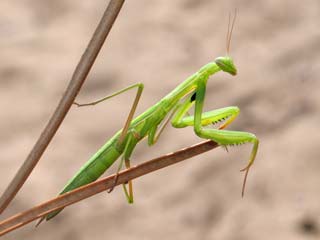Mantis
Latin name : Mantis religiosa
Family : Mantidae
Set : Mantis Mantoptera
Group : Insects
It is a large insect, 40 - 80 mm long, has two front wings and two wings after a wide development. The back wings look like glass panels and are only in the front border on the tip, the wings are light green or light brown, the chest extinguisher in front of the tube is long and on the inside of the perineum of the forelegs is 1 black dot, usually with a light brown spot in the middle.
The forelegs have the form of a blade, the inner shore has teeth, used to catch prey and fight the enemy. Females are usually larger than males (females 48 - 76 mm; males 40 - 61 mm). Colors vary according to the color of the residence (especially when prey on prey): color often appears green, pale or yellow or brown.
Biological:

(Photo: curieux-de-nature)
Food is different insects that depend on this species that appear near when they are prey, but for larvae it is selective and has certain food that is aphid. Even the Mantis eat meat together, especially the female can eat the male right in the mating time or after that. Spawning time from early summer to late autumn.
Females lay eggs after mating for a long time. One lays about 100-300 eggs at regular intervals in the nest. Mantis eggs laid in the summer or early autumn bloom right out after a short period of time (about 1 month). Mantis eggs laid in late autumn often live through the winter until the spring is newly hatched and the larvae grow very quickly and after 4 molting times mature to mature form.
Habitat and ecology:
Body color often carries a camouflage protection product suitable for the color of the tree and the place of life, this species has 3 basic colors as described above. Often meet them on big trees, shrubs rather than on grass plants.
Distribution:
- Vietnam: throughout Vietnam, according to documents found in Lang Son, Quang Ninh, Ninh Binh, Quang Binh, this is the only species of Mantodea mantis in Vietnam red book.
- World: is a species widely distributed in both temperate and tropical regions of continents: Europe, Asia, Africa, even in North America and Australia.
Use value:
These insects are more beneficial than harmful because they kill many harmful insects, especially they eat a lot of plant aphididae (Aphididae). They also beautify nature. However, sometimes they also eat honey bees and other beneficial insects.
Status:
The number of this mantis species is very rare and rare because of environmental factors and enemies and cannibalism and in Vietnam children often catch to play. Many countries classify them as rare insects.

(Photo: carnet)
- Video: Praying mantis still mating
- An emergency escape when the
- Terrifying truth: Mantis hunt birds and eat prey's brain as soon as they are alive
- Eyes of mantis shrimp
- Praying Mantis prey with a flower-like shape
- Discovering new abilities of mantis shrimp
- Fall in love with the world's most beautiful mantis
- Heavy shock at the sight of the mantis killing the snake
- Scientists discovered mantis hunting fish
- Shocked before mantis scene
- Close-up of beautiful assassins
- The male mantises are chewed after their love, but they are not as miserable as you think
 Why do potatoes have eyes?
Why do potatoes have eyes? 'Tragedy' the world's largest carnivorous life: Death becomes ... public toilet
'Tragedy' the world's largest carnivorous life: Death becomes ... public toilet Tomatoes were once considered 'poisonous' for 200 years
Tomatoes were once considered 'poisonous' for 200 years Detecting microscopic parasites on human face
Detecting microscopic parasites on human face